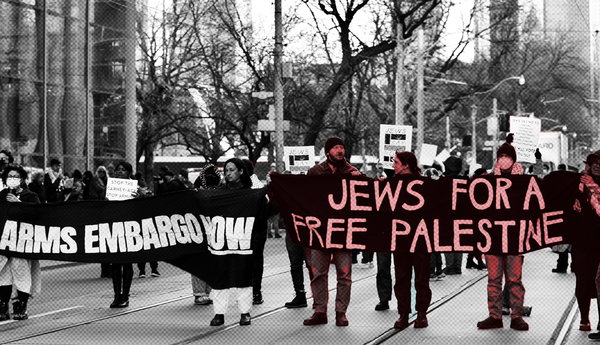The federal government is refusing to say whether or not it made the decision to green-light nearly $1 million in new military exports to Peru during a period of brutal crackdowns by the country’s government against Indigenous-led protesters.
Documents obtained by Amnesty International Canada through an access to information (ATIP) request and shared with The Maple show that Global Affairs Canada (GAC) authorized new exports of military goods to Peru valued at $960,000 for a three-year period starting on February 6 this year.
At that time, Peruvian security forces were engaged in a particularly violent period of crackdowns against protesters, who were demonstrating against the government of President Dina Boluarte and calling for new elections. The crackdown prompted Amnesty International to call for Canada to suspend military exports to Peru.
Experts interviewed by The Maple said the permit’s “valid from” date, February 6, is not necessarily the same date that the permit was approved. GAC repeatedly refused to answer questions from The Maple about whether the ministry made the decision to authorize the permit before or after Dec. 7, 2022, when the protests against the Peruvian government began amid a political crisis.
GAC spokesperson Charlotte MacLeod said in a statement to The Maple that Canada has raised concerns about alleged human rights abuses with the Peruvian government “at various levels,” and cited “internal reports” that allegedly found “no Canadian-made military, aircraft, or technological equipment previously sold to Peru have been used in a manner inconsistent with their stated end-use and/or in violations of human rights.”
But human rights activists interviewed by The Maple said that Canada lacks a post-shipment monitoring process capable of providing such assurances.
Kathy Price, a campaigner with Amnesty International Canada, explained: “There’s no post-shipment controls. There’s no post-shipment monitoring. There’s no on site verification to ensure that the Canadian exports were not used in the repression.”
Last year, Canadian military exports to Peru included “ground vehicles,” as well as an export category that includes “riot control agents,” and aircraft and technology. In July 2022, five months before the protests in Peru erupted, then-defence minister Anita Anand was instructed to lobby her Peruvian counterpart to buy more Canadian-made military supplies.
GAC is bound by the Arms Trade Treaty (ATT) and Export and Import Permits Act (EIPA) to assess whether there is a substantial risk that military goods “could be used to commit or facilitate a serious violation of international human rights law.”
Regarding the February 6 permit for this year, MacLeod said the ministry “does not comment on individual permits or permit applications. The specific details of items exported under an export permit are protected commercial information.”
However, all identifying details about the permit holder — including its name, address and detailed descriptions about its products — were redacted in the copy of the permit viewed by The Maple.
The Maple pointed this out and asked GAC if it had approved any military export permits to Peru on or after Dec. 7, 2022. The ministry gave no further response. The ministry also did not answer questions about whether it is reviewing approvals for future military exports to Peru.
According to Canada’s 2022 annual report on military exports, “The processing time for export permit applications to low-risk destinations that contain all required supporting documentation is 10 working days.”
For other destinations, including Peru, “the processing time is 40 working days.” The report states the performance target for meeting these timelines is 90 per cent.
What Was Exported?
Military exports are categorized under Canada’s Export Control List (ECL). The February 6 permit lists ECL categories pertaining to “infrared or thermal imaging equipment,” production equipment, and military technology and software.
In a press release published on April 4, General Dynamics Land Systems-Canada (GDLS-C) said it had recently signed an agreement “with the Peru Ministry of Defense, as part of our partnership on the Super Seasprite SH-2G Program with the Marina de Guerra del Peru.” GDLS-C described the deal as “another example of our ongoing work to deliver the best [anti-submarine warfare] technology.”
The Maple asked GDLS-C if it was the holder of the February 6 permit and if the permit related to the April 4 statement. In an emailed response, the company said it had “no information to provide on this matter.”
The Maple contacted a second major supplier of such goods, but did not receive any response.
As explained by arms monitoring expert Kelsey Gallagher in a previous interview with The Maple, Canada’s export control categories provide only broad strokes about the kinds of military goods being sold to foreign governments and their militaries.
Figuring out the exact nature of the goods typically relies on the suppliers themselves disclosing such information in their own press releases. But some suppliers are not forthcoming with such information, particularly when the end users are likely to attract controversy and criticism.
“The fact that we’re looking at a series of [ECL] numbers and not getting any further information does strike me as an issue related to transparency,” Gallagher told The Maple regarding the February 6 permit.
That concern was also shared by Brent Patterson, director of Peace Brigades International - Canada.
“One of the many troublesome aspects of this, always, is the lack of transparency,” Patterson told The Maple. “I think we’re intentionally left in the dark in terms of trying to piece things together.”
“It’s just fundamentally inappropriate and wrong that we don’t have this information as a matter of public record.”
He added that it is concerning to see no sign of there having been a pause on military exports to review such sales to Peru in light of the brutal crackdowns.
Crackdowns In Peru
Marina Navarro, executive director of Amnesty International Peru, told The Maple that protests emerged out of the country’s ongoing political crisis at the end of last year. The crisis followed the ousting and arrest of left-wing president Pedro Castillo, who was replaced by his vice president, Dina Boluarte.
Castillo had attempted to dissolve congress and called for new legislative elections while facing impeachment charges. Predominantly Indigenous protesters from the country’s rural areas responded to the ousting of Castillo by blocking roads and taking to the streets, demanding new elections and constitutional reforms.
“Those protests, from the very beginning, started to be repressed very strongly from the armed forces, both the army and the police,” said Navarro. Those forces used live ammunition on the demonstrators.
“In two months, 49 people were killed by the armed forces in Peru,” she explained. “And hundreds of people were wounded or injured.”
Amnesty International Peru said it conducted intensive on-the-ground investigations, and found evidence of at least 20 potential cases of extrajudicial executions committed by Peruvian security forces against unarmed protesters, who were shot in the body and head. Medical workers attempting to tend to the wounded were also shot and killed, Navarro said.
The crackdown also had a clear racial bias, she explained: “Eighty per cent of the people that were injured or killed were Indigenous people.”
That violence came against a backdrop of top government officials using racist narratives to dehumanize the protesters, Navarro said. “They were saying that the people were ‘terrorists,’ that all those people were being used by others; many called them animals,” she explained. “What we heard from [the protesters] is that they have been treated worse than animals.”
In a press release this week, Amnesty International Peru noted that on November 27, the country’s attorney general, Patricia Benavides, presented a constitutional complaint against Boluarte and several cabinet ministers for their roles in the violence, hours after prosecutors accused Benavides of directing a criminal network of corruption.
“The constitutional complaint before the Congress took a small portion of the information from a much larger ongoing criminal investigation against the president, which remains in the hands of staff in the Peru’s Public Prosecutor’s office and must be expedited without delay,” the statement said.
Amnesty International Peru said that the overall state of investigations into the deaths of protesters remains “extremely concerning,” with basic tasks still not completed.
“In the current context, it is imperative that prompt, thorough and impartial investigations are ensured. Investigations must not be shelved because they ignored or omitted key evidence,” the press release added.
Calls For Canada To Act
Price, the campaigner at Amnesty International Canada, told The Maple that in meetings with GAC officials to discuss Amnesty’s call for Canada to suspend arms exports to Peru, the ministry claimed that the Canadian export system was “robust” and would not allow for weapons to end up in the hands of human rights abusers.
But the emergence of the February 6 permit casts doubts on that claim, Price explained. “For us, it was just another piece of evidence that speaks to a concern that we should have with the system. It’s not a transparent system.”
This lack of transparency also means it is unclear whether past Canadian military exports — including guns, armoured vehicles and riot gear — may have been used in the crackdown against protesters, said Price.
“We don’t get answers to our questions; we don’t get replies to our calls for a suspension of arms exports; we see that there appears to be a double standard,” Price added, noting that Canada has suspended arms exports over human rights concerns to other countries, such as Turkey and Belarus. Spain and Brazil, meanwhile, both paused exports to Peru.
“We made the call that we did because our colleagues with Amnesty Peru, who were documenting the consequences of the repression that was unleashed against protesters in Peru, asked us to,” Price explained. “They said that this is the most important thing that you can do.”
Patterson agrees that GAC’s claims about the robustness of its vetting process are dubious.
“We’re assured that there’s this kind of robust assessment beforehand that we don’t see, that surely cannot be all that robust when we see the countries or the situations in terms of where Canadian-made weapons are sold,” he explained.
Canadian Mining Interests
Looming large over Canada’s relationship with Peru is the Canadian mining industry, which holds nearly $10 billion worth of assets in Peru. Canada is the third-largest investor in Peru’s mining industry, and is the country’s largest foreign investor in mining exploration.
In separate GAC documents obtained by The Maple through an ATIP request, International Trade Minister Mary Ng was instructed to raise the “need for proportional responses by [Peru’s] security forces” to the protests in her meetings with Peruvian ministers at the Prospectors & Developers Association of Canada in Toronto back in March.
However, the briefing documents stressed: “Despite recent political difficulties, Canadian companies remain committed to their investments in Peru’s extractive sector, particularly in mining.”
Price noted that the Trudeau government’s prioritization of Canada’s commercial relationship with Peru over human rights considerations was also reflected in Ng’s public-facing statements during the convention, which also coincided with the period of brutal crackdowns against the protesters.
“There’s no mention at all of the continuing human rights crisis in [Ng’s] tweets,” said Price. “You have to ask the question, what’s driving the fact that Canada says nothing? And what’s driving the fact that Canada is not willing to even consider suspending arms exports to Peru when they were able to suspend arms exports to other countries?”
Anniversary Of Protests Brings Concern
With the one-year anniversary of the protests marked on December 7, there is concern that violent state crackdowns against protesters could resume.
“The conditions on the ground in Peru have not changed,” said Price. “[There is] stigmatization of anybody who takes to the streets to protest and calling them ‘terrorists,’ and this is in a country like Peru, where there was an internal armed conflict, and anybody who was called a ‘terrorist’ was subjected to extrajudicial executions, disappearances.”
Navarro said new protests are planned. Recently passed legislation, she explained, makes blocking infrastructure punishable with up to 15 years in jail. “The government is sending their army and the police to those areas that are mainly Indigenous areas,” said Navarro.
“We are really worried.”
Alex Cosh is the news editor of The Maple.
ATIP documents:







